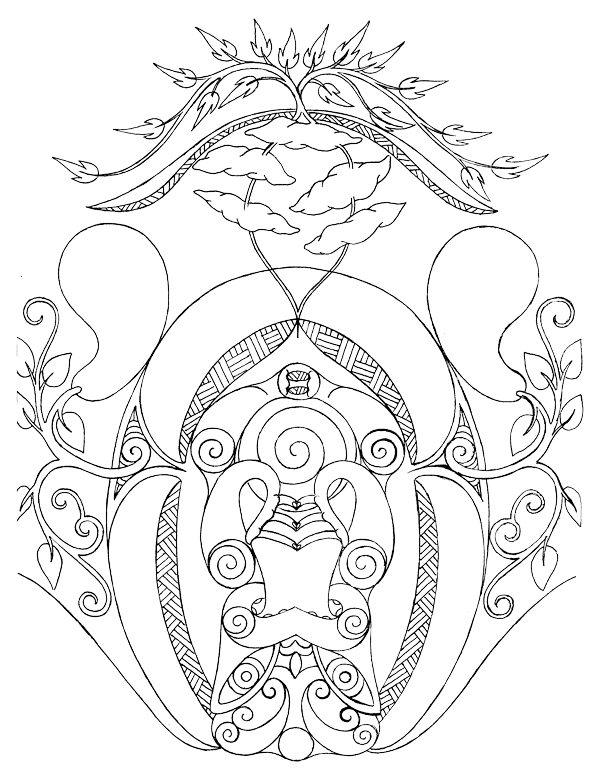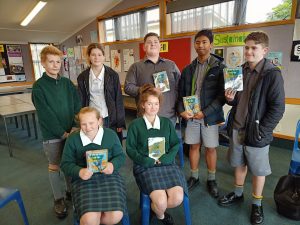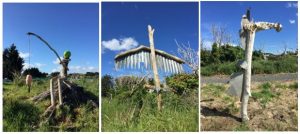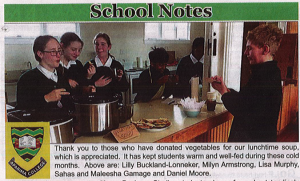
Rongomātāne - associated with garden crops with qualities of peacefulness and order, provision and cultivation.

Aparima College EnviroCouncil
In March, Enviroschools Southland Regional Coordinator, Megan Bates, came to help us with our Bronze Reflection, thinking about our place, practices, people and programmes and the way these interact to create a sustainable community, empowered students, effective learning and respect for cultural diversity. We became a Bronze Enviroschool and started working towards some Silver goals, particularly to increase staff and student engagement and to be more inclusive.
In October, Aparima College won the Keep New Zealand Sustainable Schools Award in recognition of a number of our sustainable initiatives including local tree planting (The Tree Project), waste minimisation and vegetable gardens.
“We’re doing well but we need to get more people involved. Perhaps we could have an EnviroLeader badge so people know to ask us about enviro things” – Jayden, EnviroCouncil student reflecting on the KNZB recognition
“We have done so many things this year, especially considering we lost time during Lockdown” Alexe, EnviroCouncil student reflecting on the KNZB recognition
School-based Actions
Garden Project

Students learn how to raise seedlings and plant out their kai gardens.
Supported by our Board of Trustees, Rebecca Perez has been tasked with planning and started planting a Garden beside the Tree Project, created bedding strips of compost on top of dampened cardboard to maintain moisture. She raised flower and vegetable seedlings in the small tunnel house and transferred these into the beds. Enviroschools and Aparima Community Board funding in September enabled us to purchase a larger tunnel house, currently planted out with tomatoes, cucumbers and courgettes. All food grown is destined for the students and local community. In Term 2, Nick Kiddey from the South Coast Environment Centre showed our Electives students how to collect, recognize and store seeds. During Terms 3 and 4, our Electives students have been learning how to plant, care for, and harvest the vegetables. You can read more here and watch a video here or below.
Tree Project
During Electives periods, more trees were planted, bringing the total number planted since August 2019 to over 1000. Josh Sullivan, our new Enviroschools facilitator, helped us plant native trees to stabilise the dunes, using the broom as a protective ‘nursery’ plant. The focus has now moved on to care and maintenance. Robyn Guyton pruned our heritage fruit trees to encourage them to grow a bumper crop this season. Leon Black and family donated sheep dags to spread around the base of the young trees, providing food and protection. As the grass grew around the trees, we weeded enough to stop the plants from being choked but left enough grass to protect them from the wind. Rosco and Year 12 students Jackson, Kori and Thomas have continued to make progress on the Outdoor Classroom. In November we staged a Treasure Hunt to encourage everyone to take a closer look around the area. Local lady Gay Maley donated a yellow picnic table which was well used during the Eco-Picnic and Adopt-a-Tree community afternoon held in November.
Wellbeing Walkway

Left to right: Fisherman by Josh Livingstone and Aiden Turner, Haast Eagle by Ryan King and Brayden Wilson, Seahorse by Tympani Armstrong
A Ministry of Education Creatives-in-schools grant enabled Year 10 to partner with Wayne-of-the-Hill and Teoti Jardine from the Riverton Arts Centre and Ōraka Aparima Rūnaka to explore and celebrate our connections with this place. Year 10 students were mentored to express their thoughts, hopes and dreams in poetry and to translate these into sculptures from ‘found’ materials collected from the local area.
The students explored their connection with the environment through the lens of local history and wildlife and then transformed the essence of these connections into creative writing and symbolic sculptures. These have become part of a Wellbeing Walkway through the Tree Project, designed to delight locals and visitors. Poetry was displayed at the Riverton Arts Centre’s Taiao Exhibition in March and Sculpture photographs became part of the November Aparima College Exhibition.
Waste Management

Recycling and waste management centre at the school.
The Enviro-Council identified that litter was a real problem around school and that our school was not very advanced in separating our waste. Daniel decided to take on the challenge of improving our waste systems around school. Helped by Mrs Mailman, he secured a Keep New Zealand Beautiful grant to help purchase bins to recycle plastic bottles and then took them to the Recycling Centre once a week. He kept a tally of the number and types of plastic bottles in the bins and then wrote a report on his findings and what he would like to see happen in future.
This report received an Honourable Mention in the national Young Reporters for the Environment Reduce Plastic Waste Litter Less competition, and Daniel was voted Volunteer of the Month for October 2020.

Daniel shows how the waste systems work, keeping a tally of the number and type of plastics.
Following a performance from Waste Free Wanda, Daniel asked Ange Molloy from WasteNet Southland if Aparima College could have a yellow recycling bin, so that he would no longer have to do the weekly trip to the edge of Riverton.
By November, students started to get used to separating their waste. Recycling plastics has become normalized, particularly in the Staffroom!

Student soup kitchen notice.
Soup kitchen
Mrs Mailman and volunteers from Year 7-10 helped produce soup and cheese rolls on Mondays and Tuesdays, in place of the canteen. Meals were served café-style in the Hall on china plates with metal cutlery. Scraps were composted in the Small Garden.
Out and About in our Environment
Litter Intelligence surveys for Sustainable Coastlines
The Science Department became increasingly involved in conducting our three-monthly Beach surveys. Year 9 and 10 students helped collect and sort waste from beaches near the Rugby Club, North Beach and at the estuary near Bath Road, and then upload data to the Litter Intelligence site. We also had support from Ben Knight and from two SIT students. We became a collection depot for used mobile phones, which are upcycled for their parts, and a portion of the profit is donated to Sustainable Coastlines.
Murihiku Coastal Treasures Conference
Just before Lockdown, three of our senior Enviroleaders – Dom, Alexis and Jamie – and Mrs Grove were sponsored by Toimata Foundation to represent our school at the Coastal Treasures conference, which was held in Southland this year. Experts shared best practice in dune restoration and we visited examples of ecosystem management at Waituna Lagoon, tourism management at Curio Bay and flood mitigation in Otatara. It was amazing to network with such knowledgeable and passionate people from across Aotearoa. We wrote an article that was published on the Enviroschools website.
At our EnviroCouncil meeting at the beginning of term 4 (a busy time) we discussed how the students feel about their Enviro mahi this year and the recognition that came via the Sustainable School award. They also looked at things that they wanted to achieve before the pending end of the school year.
“We really enjoyed planting trees and seeing how much they’ve grown” – David, Samantha
“We like seeing progress in the Gardens and especially the Garden Blessing we had” – Alexe, Jayden
“We have enjoyed linking our classes around the Tree Project and Garden, especially Science and English” – Jayden, Samantha
“We liked helping sort the rubbish and put out the new rubbish bins” Nikita, Lisa
“We really enjoyed helping Mrs Mailman with the soup kitchen in the winter” Nikita, Lisa
Ideas for the rest of Term 4
- paint an enviro-themed mural
- hold an Enviro Fun Day, eg. make rafts from found materials and race them down the river
- go on trips, eg. to see the planting at Bluff / Otautau Arboretum/ Otatara community gardens
Next steps
Our vision for the next year is two-fold: firstly, to consolidate what we already have, for example, by encouraging our school’s departmental leaders to integrate the Tree and Garden Projects into long-term plans and then to share their learnings. This will help us with data-gathering, maintenance and future planning based on solid evidence. (Note: We already have Maths, English and Science on board, and are reaching out to Art, Humanities and Digital Technology).
Secondly, we aim to reach out to our community for their wisdom, particularly in the area of Mātauranga Māori. Our school is based within an important traditional food-gathering area, and we are hoping to learn more about traditional practices and to reinstate some of them within our own practice, for example, by adding a maara kai to our Food Garden, by sharing kai-related pūrākau, by joining local kaumatua and kuia in learning about sustainable kai moana tikanga, and by feeding our community with locally grown kai through our Food Kitchen.
Banner image: Haast Eagle by Ryan King and Brayden Wilson – one of the sculptures that were part of a local exhibition.
